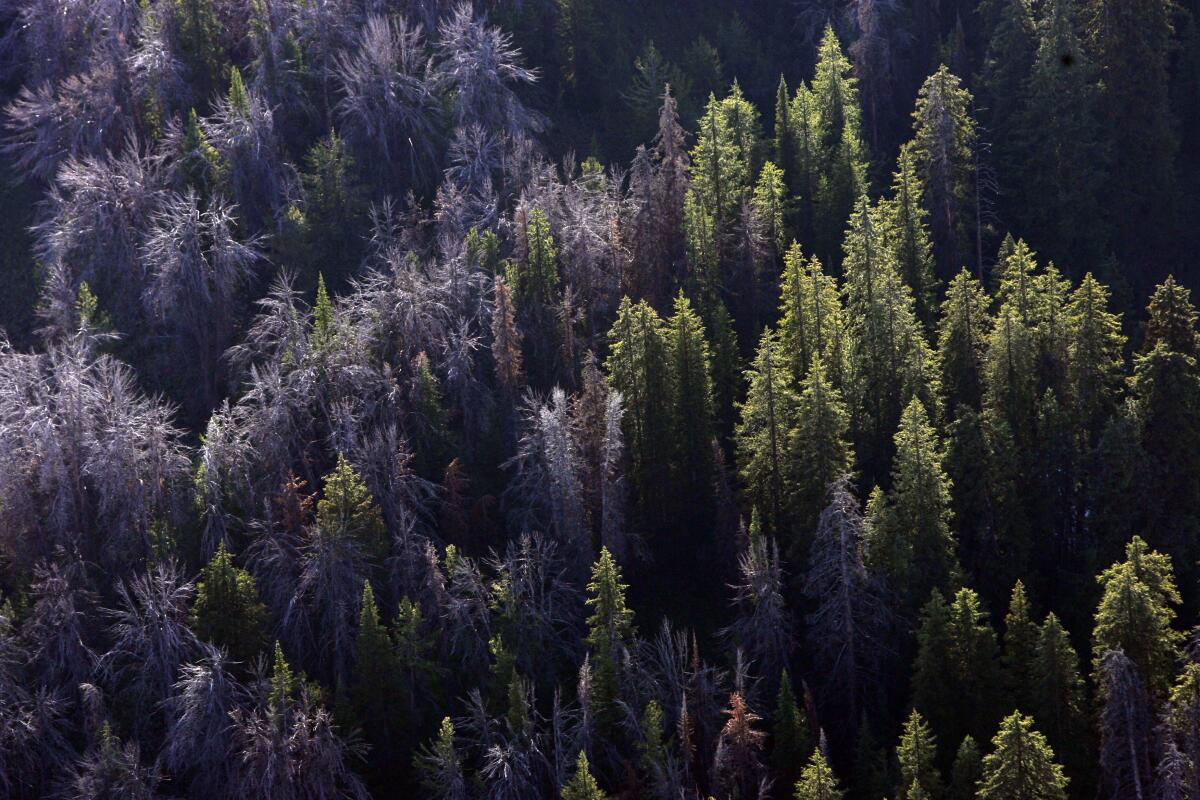Mountain pine tree that feeds grizzlies is threatened, U.S. officials say

- Share via
BILLINGS, Mont. — Climate change, voracious beetles and disease are imperiling the long-term survival of a high-elevation pine tree that’s a key source of food for some grizzly bears and found across the West, U.S. officials said Tuesday.
A Fish and Wildlife Service proposal scheduled to be published Wednesday would protect the whitebark pine tree as a threatened species under the Endangered Species Act, according to documents posted by the Office of the Federal Register.
The move marks a belated acknowledgment of the tree’s severe declines in recent decades and sets the stage for restoration work. But government officials said they do not plan to designate which forest habitats are critical to the tree’s survival, stopping short of what some environmentalists argue is needed.
Whitebark pines can live up to 1,000 years and are found at elevations up to 12,000 feet — conditions too harsh for most trees to survive.
Environmentalists had petitioned the government in 1991 and again in 2008 to protect the trees, which occur across 126,000 square miles in Wyoming, Montana, Idaho, Washington, Oregon, California, Nevada and western Canada.
A non-native fungus has been killing whitebark pines for a century. More recently, the trees have proved vulnerable to bark beetles that have killed millions of acres of forest, and climate change that scientists say is responsible for more severe wildfire seasons.
The trees have been all but wiped out in some areas, including the eastern edge of Yellowstone National Park, where they are a source of food for threatened grizzly bears. More than half of whitebark pines in the U.S. are now dead, according to a 2018 study from the U.S. Forest Service.
That has complicated government efforts to declare grizzlies in the Yellowstone area as a recovered species that no longer needs federal protection. Grizzlies raid caches of whitebark pine cones that are hidden by squirrels and devour the seeds within the cones to fatten up for winter.
A 2009 court ruling that restored protections for Yellowstone bears cited in part the tree’s decline, although government studies later concluded the grizzlies could find other things to eat.
After being sued for not taking steps to protect the pine trees, wildlife officials in 2011 acknowledged that whitebark pines needed protections but they took no immediate action, saying other species faced more immediate threats.
An attorney with the Natural Resources Defense Council, which submitted the 2008 petition for protections, lamented that it took so long but said the proposal was still worth celebrating.
“This is the federal government admitting that climate change is killing off a widely distributed tree, and we know that’s just the tip of the iceberg. There are many species threatened,” said Rebecca Riley, legal director for the environmental group’s nature program.
The government’s proposal describes the threats to the pine tree as imminent and said it was one of many plants expected to be harmed as climate change moves faster than they can adapt.
“Whitebark pine survives at high elevations already, so there is little remaining habitat in many areas for the species to migrate to higher elevations in response to warmer temperatures,” Fish and Wildlife Service officials wrote.
The officials added that overall, whitebark pine stands have seen severe reductions in regeneration because of wildfires, a fungal disease called white pine blister rust, mountain pine beetles and climate change.
Amid those growing threats, federal officials are working in conjunction with researchers and private groups on plans to gather cones from trees that are resistant to blister rust, grow their seeds in greenhouses and then plant them back on the landscape, said Fish and Wildlife Service biologist Amy Nicholas. A draft of that nationwide restoration is expected by the end of next year.
“We do have options to revive this species,” Nicholas said.
More to Read
Sign up for Essential California
The most important California stories and recommendations in your inbox every morning.
You may occasionally receive promotional content from the Los Angeles Times.













